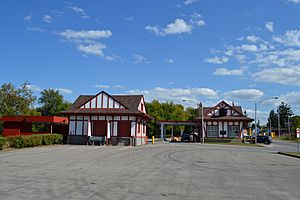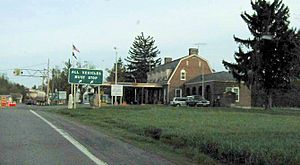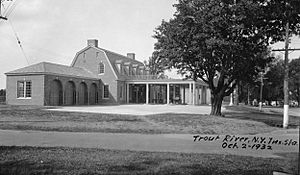Trout River Border Crossing facts for kids
Quick facts for kids Trout River Border Crossing |
|
|---|---|

Canadian Border Station at the Trout River border crossing
|
|
| Location | |
| Country | United States; Canada |
| Location |
|
| Coordinates | 44°59′31″N 74°18′30″W / 44.992062°N 74.308208°W |
| Details | |
| Opened | 1933 |
| US Phone | (518) 483-0821 |
| Canadian Phone | (514) 264-2070 |
| Hours | Open 24 Hours |
|
U.S. Inspection Station–Trout River, New York
|
|

US Border Inspection Station at Trout River, NY
|
|
| Location | NY 30, Trout River, New York |
| Built | 1931-1932 |
| Architect | Office of the Supervising Architect under Louis A. Simon and James A. Wetmore |
| Architectural style | Georgian Revival |
| MPS | U.S. Border Inspection Stations MPS |
| NRHP reference No. | 14000576 |
| Added to NRHP | September 10, 2014 |
The Trout River border crossing connects Athelstan, Quebec in Canada to Constable, New York in the United States. It is a very important spot on the Canada–US border. The main building here is called the Trout River Border Inspection Station. You can reach this crossing using New York State Route 30 on the American side and Quebec Route 138 on the Canadian side.
Historically, Trout River was the main "port of entry" for this area. A port of entry is a special place where officers check goods and people crossing the border. This means that other nearby border stations, like those at Fort Covington and Churubusco, were actually part of the larger Trout River Port of Entry.
Some buildings near this crossing are very old. They were built even before the US-Canada border was officially set in 1842. These include an old shop where you could buy things without paying taxes (a duty-free shop) and two homes.
Contents
US Border Station at Trout River
The Trout River Border Inspection Station is one of seven border stations built between 1931 and 1934 along the New York-Quebec border. In 2014, this station and others like it across the country were added to the National Register of Historic Places. This means they are recognized as important historical sites.
Why Were These Stations Built?
Border stations like Trout River are linked to four big events in American history.
- Prohibition (1919-1933): This was a time when making, selling, and transporting alcohol was illegal in the United States.
- The Public Buildings Act (1926): This law allowed the government to build many new public buildings.
- The Great Depression: This was a time in the 1930s when many people lost their jobs and money.
- The Rise of Cars: Cars became much more affordable, making it easier for people to travel.
These stations were built to help stop people from illegally bringing alcohol across the border in their cars. Building them also helped create jobs for many people who were unemployed during the Great Depression.
The Trout River border station is one of the best-preserved stations in New York. Even though some changes have been made over time, it still looks a lot like it did when it was first built. The building was designed by the Office of the Supervising Architect under James A. Wetmore and Louis A. Simon. It was built between 1931 and 1932. Many border stations built around this time in New England shared similar designs. They often looked like homes, used a style called Neo-colonial or Georgian Revival, and were set up to handle both customs (checking goods) and immigration (checking people).
A Brief History of the Station
When Prohibition started in 1919, it led to a lot of "bootlegging." This means people were illegally bringing alcohol across the Canada-US border. At first, only a few officers on foot or horseback tried to stop this. Customs houses were often far from the border, and travelers were expected to report their purchases.
The Public Buildings Act of 1926 helped change this. It gave the government money to build new stations right at the border. This made it easier to stop illegal activities. Trout River was a common spot for bootleggers to cross.
Even after Prohibition ended in 1933, the Trout River station remained important. People still smuggled things, sometimes even raw alcohol into Canada where it was more expensive. So, the station kept working to stop this.
The Trout River station was the first of seven new stations in New York to be built. It is still in use today. It is important because it shows how the government responded to Prohibition, the Great Depression, and the growing popularity of cars. The station also created many jobs for local people, both in building it and working there as customs inspectors.
The design of these government buildings, including Trout River, was overseen by Louis A. Simon. He was an architect who believed in a "conservative-progressive" style. This style often used ideas from classical Western architecture, like the English Georgian style. The Trout River station is a great example of the Georgian Revival style, which was thought to fit well in upstate New York. It was built with high-quality materials and craftsmanship.
What the US Station Looks Like
The Trout River Border Inspection Station is located at the corner of New York State Route 30 and Westville Road. You can see the Canadian border station from here.
The building is made of red brick and is an example of Georgian Revival architecture. It has a main section with two smaller parts (wings) on each side. A canopy extends from the front, covering three lanes where cars are inspected. The main part of the building has a special roof called a gambrel roof, covered in slate. It also has chimneys and decorative brickwork on the corners. The windows on the first floor are original.
The side wings have arched openings for vehicles. One bay on the south wing was changed into a bathroom for people with disabilities. On the north wing, one opening was changed to a pedestrian entry. The inspection canopy has a wrought iron railing and is supported by wooden and metal columns.
Inside the main building, the first floor has a public area and office spaces. There are also stairs to the basement and second floor. Many of the original features are still there, like plaster walls and ceilings, and red tile floors. The basement has mechanical rooms and two large safes. The second floor has offices and bathrooms with original sinks and tile. Over the years, some updates have been made, like changing the canopy supports, replacing the main entry door, and adding the accessible bathroom. A backup generator was installed in 1976.
Canadian Border Station at Trout River
The Canadian border station at Trout River has a different style. It's a 1 1/2-story building designed in the Tudor Revival style. It has a gabled roof with dormers (windows sticking out of the roof) and wide eaves (the part of the roof that hangs over the walls). The walls are stucco, and they have decorative half-timbering, which was originally charcoal-colored but is now painted red.
This Canadian station was built in 1933, making it one of the oldest border facilities still in use. The Tudor style was also used for other Canadian border stations, like those at Beebe and Lacolle. In 1991, the Federal Heritage Buildings Review Office recognized this building as a special heritage site.




